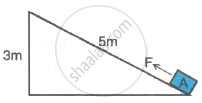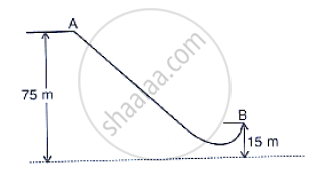Advertisements
Advertisements
प्रश्न
A block A, whose weight is 100 N, is pulled up a slope of length 5 m by means of a constant force F (= 100 N) as illustrated in the following figure.

- What is the work done by force F in moving block A, 5 m along the slope?
- What is the increase in potential energy of the block A?
- Account for the difference in work done by the force and the increase in potential energy of the block.
उत्तर
F = 100 N; S = 5 m
(a) Work done by the force F
W = F × S
= 100 × 5 = 500 J
(b) Increase in PE = mgh
= 100 × 3 = 300 J
(c) Difference in work = 500 – 300 = 200 J
This energy is used to work against the frictional force between the block and the slope of the plane, and it appears as heat.
APPEARS IN
संबंधित प्रश्न
A metallic ball is hanging by a string from a fixed support. Draw a neat labelled diagram showing the forces acting on the ball and the string.
What is meant by the gravitational potential energy?
Two bodies of equal masses are placed at heights h and 2h. Find the ratio of their gravitational potential energies.
Find the gravitational potential energy of 1 kg mass kept at a height of 5 m above the ground. Calculate its kinetic energy when it falls and hits the ground. Take g = 10 m s-2.
Calculate the height through which a body of mass 0.5 kg is lifted if the energy spent in doing so is 1.0 J. Take g = 10 m s-2.
A man of mass 50 kg climbs up a ladder of height 15 m. Calculate:
- the work done by the man,
- the increase in his potential energy. (g = 9.8 m s-2)
The diagram given below shows a ski jump. A skier weighing 60 kgf stands at A at the top of ski jump. He moves from A and takes off for his jump at B.

- Calculate the change in the gravitational potential energy of the skier between A and B.
- If 75% of the energy in part
- becomes kinetic energy at B.
- Calculate the speed at which the skier arrives at B. (Take g = 10 m s-2)
Draw a graph of potential energy vs height for a body thrown vertically upwards. [Assume no friction is present.]
Write an expression for the potential energy of a body of mass m placed at a height h above the earth's surface. State the assumptions made, if any.
A box of mass 300 kg has gravitational potential energy stored in it equal to 29400 J. Find the height of the box above the ground. (Take g = 9·8 N kg-1).
